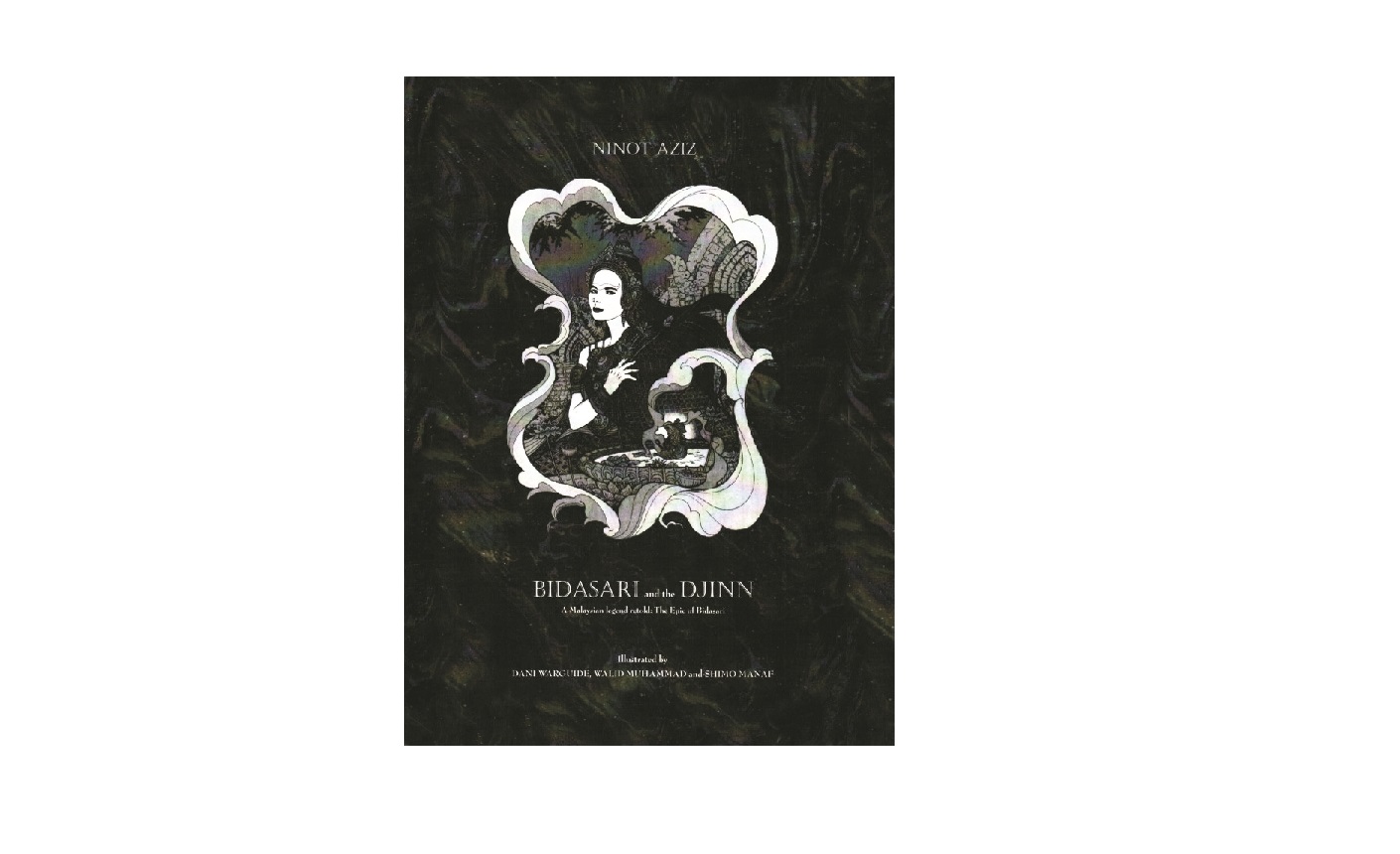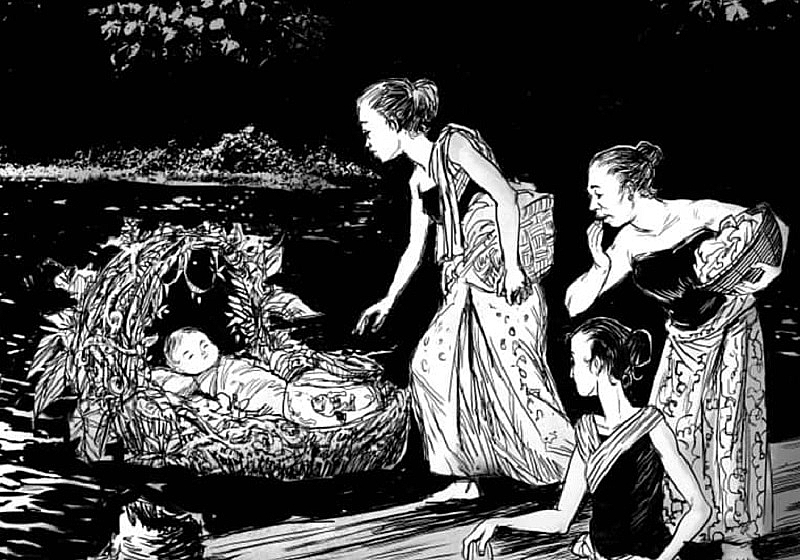
Ninot Aziz throws in a Malaysian twist to the classic Sleeping Beauty tale in Bidasari and the Djinn (Photo: Silverfish Books)
Bidasari and the Djinn, retold by Ninot Aziz, is an enchanting tale about the beautiful Princess Bidasari and her mystical goldfish. A famous story shared around the Nusantara, it is based on the well-known 18th-century poem, Syair Bidasari.
Southeast Asia, an ancient maritime hub, had many royal courts where oral storytelling took place to entertain, instil moral values and impart wisdom. Ninot Aziz’s story is filled with palace drama, evil flying beasts, witches, magic potions and dashing heroes who come to the rescue of chaste maidens.
Set in the kingdom of Kembayat, which many believe to be ancient Champa, Bidasari is filled with dramatic black-and-white illustrations characteristic of the region. The storyteller is a frail, old man called Tok Bo, a djinn in disguise who has lived long and witnessed events over many generations. He tells this story to a group of children in his village.
Long, long ago in a faraway land called Kembayat, there lived the noble Sultan Po Angkasa and his beloved wife, Sultanah Po Dewi Alam, who were much loved by their subjects. Kembayat was thriving, with verdant paddy fields, pastures and a bustling river that connected fishermen and merchants to the villages along its banks.
The sultan loved his wife and could not ask for more as his people were prosperous and peaceful. But they yearned for a child who would one day inherit the glorious kingdom. So they prayed for a virtuous offspring, one blessed with beauty, grace, kindness and wisdom.
One day, the sultanah discovered she was with child and the people of Kembayat celebrated the news with joy. But their happiness was short -lived. Nine months later, an evil garuda attacked the kingdom, destroying homes and killing people. Desperate to save his wife and unborn baby, the sultan and his family fled to the jungles.
She arrives in the land of dreams,
a beauty they had not expected.
There by the river bank, a beautiful princess was born. Suddenly a goldfish with glistening scales appeared by her side. It became clear to the royal couple that the creature was spiritually bonded to their daughter for when it swam happily, she would gurgle cheerfully. But whenever the sultan lifted the fish out of the water, she stopped breathing.
To ensure that the princess would stay alive, the sultan and his wife, with heavy hearts, placed her together with the goldfish in a golden bowl on a raft, and set it adrift downstream to the neighbouring kingdom of Indrapura (believed to be the state of Pahang), where she would be safe. There, the babe was found by merchant Djouhara and his wife, Lady Leila.
Stunned by their discovery, the childless couple happily adopted her as their own. They, too, realised that the life of the girl, whom they named Bidasari, was dependent on the goldfish, which they called Bo. Aware of this magical bond, they built a protected garden richly decorated with gemstones, with fountains and streams that flowed into a picturesque pond for the creature to live in peace alongside Bidasari.

Bidasari grew up to be beautiful and learned as well. Courtiers, nobles and famous warriors were charmed by her refinement and everyone who met her could not stop talking about her. She brought much joy and success to the family as the merchant accumulated great wealth after she came into their lives.
Alas, Indrapura had a jealous and evil queen who craved power. Lila Sari was obsessed with her own youth and had a magic mirror that spoke to her about her unparalleled looks. She feared losing King Djohan, whom she had tricked into marriage, to someone finer than her. When news of Bidasari’s unrivalled beauty reached her ears, the jealous queen resorted to witchcraft and malevolent activities to destroy her and Bo.
Lila Sari decided to visit Djouhara and Lady Leila to size up Bidasari for herself. When the young lass was presented to her, the queen was struck by her divine presence. Bidasari’s face was framed by eyebrows shaped like the crescent moon and her nose was small and delicate, like a jasmine seed. Her fair complexion was as fine as crystal and her hair hung like palm blossoms.

The desperate Lila Sari then deceived Bidasari into living with her as a royal companion. But upon arriving at the palace, the girl was banished to the outer reaches of the palace grounds to live as a servant. When the queen tried to destroy her lovely looks, she discovered that Bidasari’s life was linked to Bo. Enraged, she set out to find the fish.
From here, the plot thickens with many tricks and turns. Bo was captured and taken out of water. As expected, Bidasari fell unconscious and was returned to her parents, seemingly in a deep slumber from which she would never awaken. Devastated but determined to find a way to revive her one day, Djouhara and Leila built a special palace deep in the jungle where they laid their daughter to rest.
But like all romantic stories, good overcomes evil and true love conquers all. King Djohan fortuitously stumbled upon the sleeping Bidasari on one of his hunting trips and went to her rescue. He also saved Bo from the clutches of Lila Sari, whose cruel deeds were exposed. The good maiden was reunited with her fish and “they all lived happily ever after”.

Of course, the ending would not have been complete without the handsome king falling in love with Bidasari, after he had banished the queen. As Lila Sari slunk away, a beastly looking naga was spotted leaving the kingdom, never to be seen again. Bidasari was reunited with her adoptive and birth parents, who were delighted to find Kembayat’s long-lost princess.
Our very own fable from the ancient Malay world, Bidasari and the Djinn has all the ingredients of love, drama and suspense as the European equivalents. Detailed illustrations by Dani Warguide, Walid Muhammad and Shimo Manaf succeed in captivating and drawing the reader into the exciting realm of asiatique fantasy. And, at the end of the story, we discover who Tok Bo is.
Although it has similarities to Snow White and Sleeping Beauty, Bidasari and the Djinn is enchanting in its own unique way and is wonderful for a storytelling session for all.
Ninot Aziz, who hails from a family of renowned storytellers from Chenor, Pahang, takes on the challenging task of bringing back the glory of our very own ancient tales with renewed vigour. Her writing flows beautifully and the book is in a class of its own. I am looking forward to discovering more Malay legends from Ninot and gain richer understanding of our literary history and culture.
Ninot Aziz's 'Bidasari and the Djinn' is available at Silverfish Books for RM60. Buy here.


